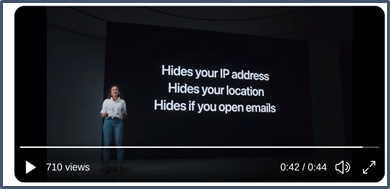What Apple's Upcoming Privacy Changes Mean For Email
Email, and marketing in general, has been going through a privacy renaissance over the past few years. From GDPR to CCPA to Google announcing the end of support for third-party cookies in Chrome, the privacy landscape has been evolving rapidly.
Apple has been an active participant in these privacy evolutions and, in fact, they term privacy a fundamental human right. In actions, they’ve historically been aggressive, allowing users to opt out of app-based tracking with their App Tracking Transparency feature and supporting single-use anonymized app email addresses with Apple Private Email Relay. So it shouldn’t have come as a surprise when they upped the ante at WWDC 2021 by announcing two new privacy features which will be launched this fall as part of iOS 15.
What Did Apple Announce?
Apple announced two features relevant to email at WWDC: Apple Mail Privacy Protection, which changes the way that opens are tracked in Mail.app clients, and Apple Private Relay, a service inside the subscription iCloud+ which will affect the way that device fingerprinting and geolocation work inside Safari. In this article, we’ll focus just on the changes coming with Apple Mail Privacy Protection, because it has the largest impact to email marketing today.
There’s a lot of conjecture in the marketplace around exactly what Apple Mail Privacy Protection is, but let’s look at how Apple announced it and take their statements at face value.

The first two of these statements are not revolutionary. Google (and Yahoo and others) image proxies have effectively obscured IP (and thus location) as well as device information for open pixels for years. This can cause issues for some advanced analytics, particularly around the devices that users use or the countries/regions they come from (if you don’t have this from signup data, which you should), but is by-and-large not a big deal. The biggie here, which immediately sent shocks through the email industry, was the third item. Taken at face value (which given Apple’s aggressive historical stance on privacy is the only reasonable thing to do), this means that either mail pixels will either never fire or always fire. The former is likely impossible to achieve without breaking email, and so the likely behavior is that the mail client will prefetch all the objects in the background regardless of whether a user opens the mail. This would mean that for users using any modern version of Mail.app, opens would be unreliable.
What is the breadth of the impact?
In talking with customers over the past few weeks, there’s been some confusion over how broad this impact is. Again, taking Apple at their word (and testing with iOS 15 Developer Beta), it’s clear that this is not just a feature for iCloud email addresses, but a general feature in Mail.app, the default mail client on all Apple devices (iPhones, iPads, and Macs). Within our data, we see ~40% of opens coming from one of these three platforms. Further, because Apple is going to ship this feature as on by default, the impact is likely high. When Apple introduced App Tracking Transparency, the adoption rate was estimated at 96%.
How does this impact marketers, and what should we do?
Here are the top five impacts for senders from this change.
1. Performance Metrics
If 40% of your mail opens all the time, it will heavily skew your open rates (and any derivative rates like CTOR). Because people use Mail.app clients with all mailbox providers, this skew will occur across all of your email.
Prediction: to combat this skew, the three most effective things senders can do are:
- Calculate open rates and click-to-open rates only for non-Mail.app clients, and to use that subset as representative of the population.
- Leverage panel data, mailbox provider data feeds and other technologies that don’t rely on pixel or object fetch tracking to measure inboxing and open rates.
- Look more heavily to meaningful business metrics like conversion rates to truly measure campaign performance.
2. List Segmentation and Automation Triggers
Opens have long been a critical signal for segmenting users by engagement level, as well as for triggering email and Ominchannel-Platform-As-A-Service (OPAAS) messaging.
Prediction: It will be necessary to refine your workflows to use more definitive signs of engagement like clicks or conversion actions outside of email. Because opens via Mail.app can still be definitively identified, it’s possible to create these new processes just for Mail.app users if that is worth the effort in your program.
3. List Hygiene
Similar to segmentation, opens have long been used as a critical part of list hygiene strategies to remove unengaged users from lists to avoid both holistic engagement-based filtering at mailbox providers as well as avoiding spamtraps (which should never engage with mail). When opens are no longer reliable, marketers will need to fight the temptation to fall back into bad practices.
Prediction: Now is the time to fully embrace confirmed opt-in as a practice on all mail. Having true confirmation from users of interest has always been the gold-standard for email programs, and the elimination of opens as a ‘crutch’ may be one of the best things to happen to email in a while.
4. Send Time Optimization
The primary metric that most send time optimization products use to derive the ideal open time is opens. This change will result in STO products becoming less accurate.
Prediction: Vendors implementing STO will need to retrain their models on clicks or other out-of-email behaviors. Systems like Verizon Media Group’s View Time Optimization, which don’t rely on open pixels/objects will become more valuable.
5. Live Content in Email
Live content is different from dynamic content in that it updates when the user opens the mail. For Mail.app users live content will break as it will be pre-fetched (and thus determined) asynchronously from an actual open and without usable geographic identifiers.
Prediction: This change will have huge impacts on live content and the companies that supply those technologies. With live content not working across ~40% of mail, content will need more dynamic (send-time) personalization. You can already see this pivot in the messaging from some of the large players in this space.
The changes Apple has in store are large, but there are opportunities here for our industry to embrace these changes and to come out stronger. By embracing user-privacy and evolving the metrics and signals we look at to get closer to customers, we can not only surmount these challenges but end up with better metrics and better practices as a result.
Check out related articles in our OI Pixelgeddon Resource Center
Curious to hear more?
Register today for this free webinar hosted by Only Influencers.
Pixelgeddon: Thriving in a Post-Pixel Email Marketing World
Tuesday, June 29, 2021 | 12:00 Noon to 1:00 PM ET
Register Today: https://risingmedia.swoogo.com/OI210629
 Cover Photo by Bradyn Trollip on Unsplash
Cover Photo by Bradyn Trollip on Unsplash

 How to resolve AdBlock issue?
How to resolve AdBlock issue? 

 George Schlossnagle is a Co-Founder, Distinguised Engineer, and a Member of the Board at SparkPost (recently acquired by MessageBird). George has been working in email since 1999, when he and his brother began developing what would become the Momentum mail transfer-agent at OmniTI. Following the spin-out of SparkPost from OmniTI in 2008, George held the roles of CEO and CTO before moving into his current role in 2020. Through the expansive Momentum on-premises footprint and his role moving SparkPost into the cloud, George has overseen the evolution of enterprise-grade email sending and analytics over the past two decades.
George Schlossnagle is a Co-Founder, Distinguised Engineer, and a Member of the Board at SparkPost (recently acquired by MessageBird). George has been working in email since 1999, when he and his brother began developing what would become the Momentum mail transfer-agent at OmniTI. Following the spin-out of SparkPost from OmniTI in 2008, George held the roles of CEO and CTO before moving into his current role in 2020. Through the expansive Momentum on-premises footprint and his role moving SparkPost into the cloud, George has overseen the evolution of enterprise-grade email sending and analytics over the past two decades.